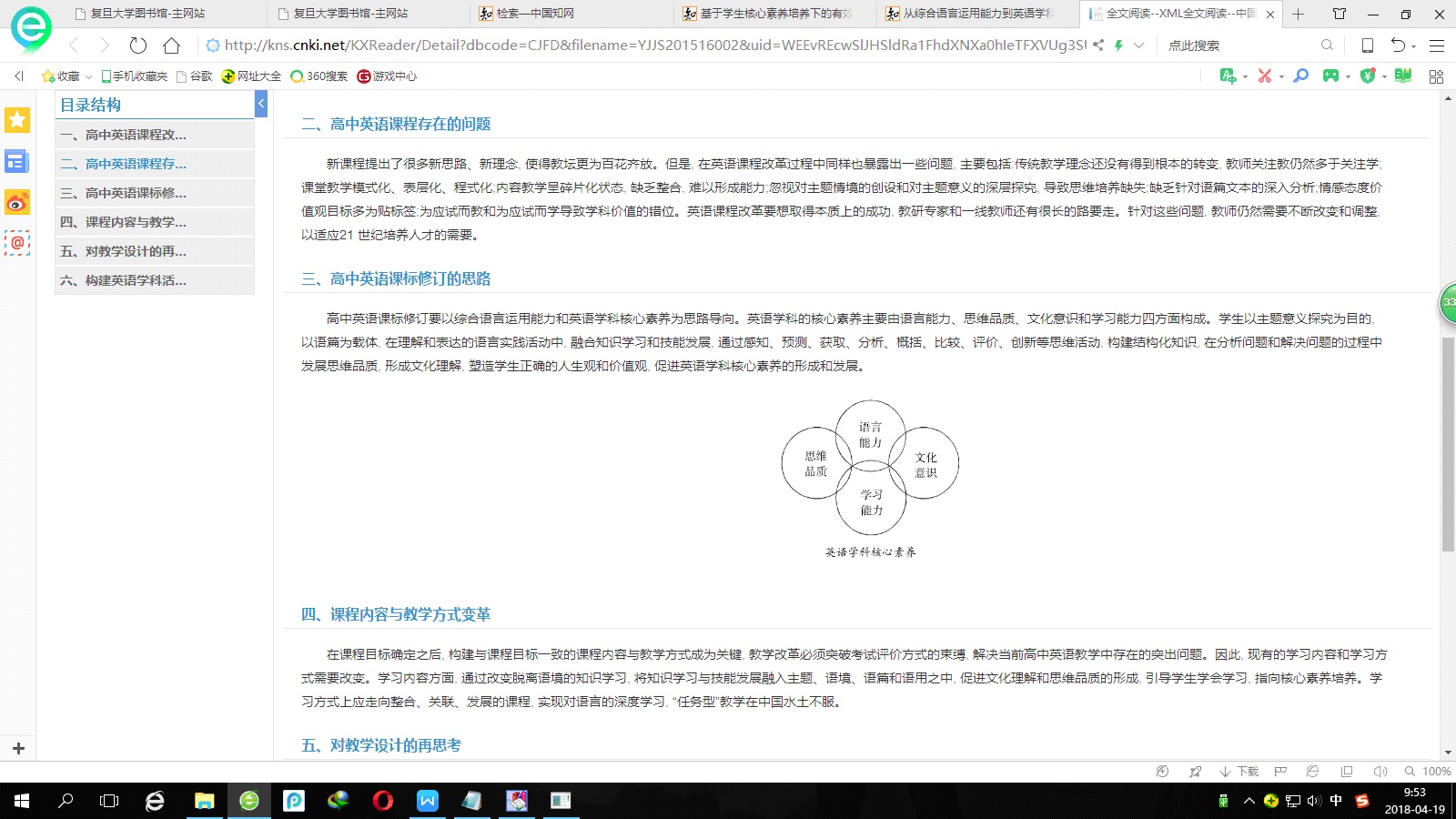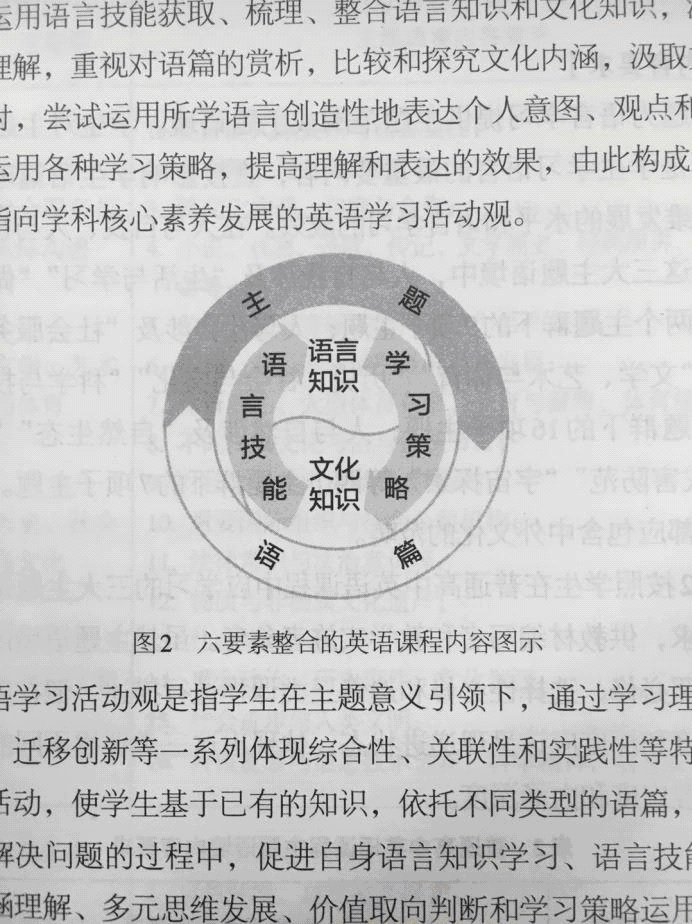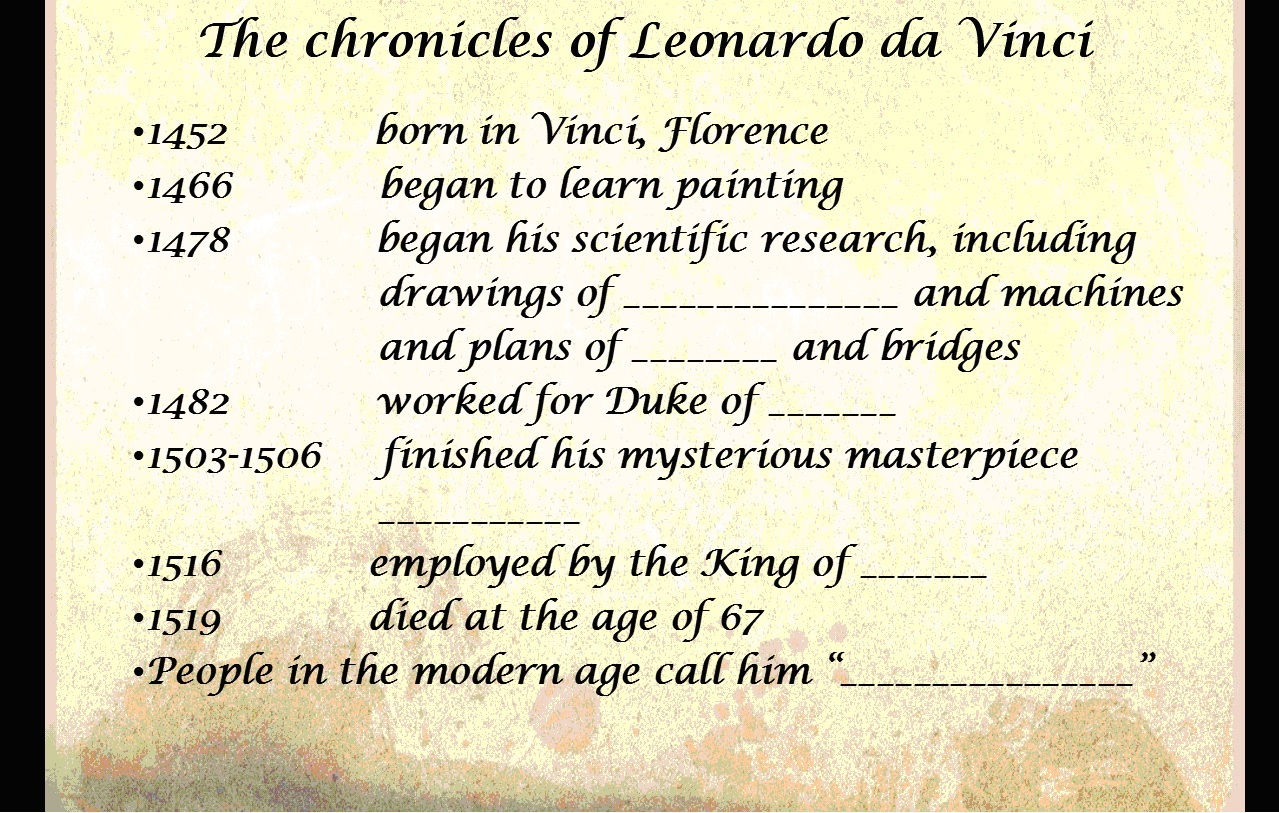把握核心素养,重构阅读教学
自2013年起,我国教育部启动了普通高中课程修订工作,将普通高中课程方案和课程标准修订成既符合我国实际情况,又具有国际视野的纲领性教学文件。在今年新颁布的《普通高中英语课程标准(2017年版)》(下称“课程标准”)中除了进一步明确普通高中教育的定位并优化课程结构之外,还着重细化了英语学科的核心素养,对知识与技能、过程与方法、情感态度价值观三维目标进行了整合,并指出课程标准应围绕核心素养的落实。作为身处教育一线的教师,则更应细致把握本次修订的脉络,着眼于培养学生的英语学科核心素养,从而提升英语教育教学质量。
•  英语学科核心素养内涵:
英语学科核心素养内涵:
(图1)
2017版课程标准中指出,学科核心素养是学科育人价值的集中体现,使学生通过学科学习逐步形成的正确价值观念、必备品格和关键能力。在2011年版的《义务教育英语课程标准》中就已经初步提出了英语学科的核心素养(如图1)。
在2017版课程标准中,进一步细化了学科核心素养,主要包括语言能力、文化意识、思维品质和学习能力。这就要求教师在教学过程中不仅要注重对学生听、说、读、看、写等能力的培养,还要通过英语课程培养学生对中外文化的理解和对优秀文化的认同,提升学生的逻辑性、批判性创新性思维,鼓励学生养成良好的学习习惯,多渠道获取学习资源,自主、高效地开展学习。英语课程内容包含六个要素,即主题语境、语篇类型、语言知识、文化知识、语言技能和学习策略(如图2)。
 (图2)
(图2)
英语教学应使学生基于已有的知识,依托不同类型的语篇,在分析问题和解决问题的过程中,促进自身语言知识学习、语言技能发展、文化内涵理解、多元思维发展、价值取向判断和学习策略应用。这一过程既是语言知识和语言技能整合发展的过程,也是文化意识不断增强、思维品质不断提升、学习能力不断提高的过程。
• 课题与教学设计背景:
建构主义认为,知识不是通过教师传授得到,而是学习者在一定的情境即社会文化背景下,借助学习是获取知识的过程其他人(包括教师和学习伙伴)的帮助,利用必要的学习资料,通过意义建构的方式而获得。在面对一些难度较高、话题不熟悉的阅读文章时,如果一味地由教师单向灌输传授,往往会适得其反。学生无法对话题引起兴趣,在阅读时又会产生畏难情绪,不利于在阅读中培养学生的逻辑思维和辩证思维,也无法唤起学生欣赏文化、学习文化的自觉性。因此,如何创设有效情境,在授课过程中有层次、分步骤地引导学生层层深入地理解文章成为笔者在教学过程中反复思索的问题。如果引导得当,则学生不仅能够对文章有较为扎实的掌握,还能自觉地结合已有知识,引发对文章中某些问题的观点的深层思考。
本次笔者所选择的是外研社《英语》顺序选修8 Module Two的阅读文章:The Renaissance。全文共583字,篇幅较长,生词较多,学生在阅读时会面临许多难题。另外,这篇课文所的主题为文艺复兴,这个话题无论从时间上还是空间上都离学生的日常生活较为遥远,学生在阅读文章时,不仅要克服语言带来的重重困难,还要突破文化背景的障碍,与文章产生共鸣,可谓挑战巨大。那么如何才能避免学生在阅读改文章之前就在心里层面对其排斥呢?笔者在授课前曾收集了大量的展览讯息,并有意识地引导学生在课余时间自行前往观展,使学生在上课前就对艺术有了初步的关注和了解,这样一来文章就不是完全陌生的内容,也更容易引起学生的兴趣。
• 教学设计及其说明:
• 教学目标的确定
基于以上的教学背景和学情分析,笔者制定了本课的教学目标如下:
By the end of the lesson, the students are expected to:
• figure out the general idea of the text, extract detailed information and have a thorough understanding of the Renaissance.
• apply what is learned about the Renaissance to problem analysis and plan-making.
• foster readiness to explore more about the Renaissance spirit.
笔者希望通过本节课的教学,使学生能够掌握这个较难语篇的大意,根据教师的指示搜集信息,还原出文艺复兴时期的历史全貌;在学习过程中能够主动运用所学的知识进行活动设计和计划制定;在对问题的思考和讨论中培养分析推断信息的逻辑能力与正确评判各种思想观点的能力;并且在学完整片文章之后从心底升腾出对文化艺术的热爱。
笔者在备课时发现文章中多次出现达芬奇,作为例子讲述文艺复兴的各种特征,但学生在阅读时可能会被不时出现的达芬奇打断思路,影响他们的理解。另外,笔者认为达芬奇这个例子本身非常具有代表性,应该突破文章原有框架,对其充分以利用,以期使学生在阅读的过程中深入思考“个人与时代的关系”这个问题,提高学生的思维品质,加深他们对文艺复兴这个时代的理解,从而能在课后进行自主探索和研究。
• 教学活动的设计
由于本篇文章难度较大,学生无法轻易达到笔者设定的目标与要求;同时,文章不仅用大量篇幅描述了文艺复兴各方面的概况,还将达芬奇这个人物作为典型事例,穿插在整篇文章中,进一步加大了学生阅读和理解的难度。因此必须层层深入,不断对学生进行引导,才能使学生充分消化输入部分,并能进行有效输出。
在读前阶段,笔者以国家博物馆策展人的身份带领学生踏上艺术之旅。首先,笔者向学生展示一则在艺术圈引起轰动的消息:一幅名为《救世主》的画作在佳士得拍得4.5亿美元,创下了世界纪录。许多学生对此有所耳闻,并且知道该画作的作者是闻名遐迩的达芬奇。笔者抛出问题"What do you know about da Vinci?"学生进行头脑风暴,得出的答案大多与达芬奇的画家身份有关(painter, talented, Mona Lisa,etc.)在学生回答后,笔者向学生介绍了一些有关达芬奇的有趣的小知识,包括他奇怪的名字Leonardo di Ser Piero da Vinci,学生会立刻对达芬奇本人及其所处的时代产生兴趣,而笔者也就能非常自然地过渡到本课的主题——文艺复兴。这样一来,学生能够自觉主动地走进这个陌生的历史时期,为他们学习课文、理解课文奠定良好的基础。
在读中阶段,笔者由浅入深地引导学生阅读与思考。读中阶段的任务一是快速阅读全文并填写完成达芬奇的生平。由于达芬奇的信息散落在文中各处,因此设计这一活动的目的是为了训练学生的跳读能力,学生不需要对信息做过多处理,只需进行搜寻,并按照表格的时间顺序进行填写(如图3)。学生在泛读过程中了解了达芬奇的生平,也窥探到了他在文艺复兴中的各种成就。
 (图3)
(图3)
那么,造就了大师达芬奇的时代是什么样的时代呢?接下来,笔者要求学生重点阅读1-2段,找出文艺复兴的涵义,时间,地点,哪些领域得到发展,以及对这个时代的描述。学生通过阅读对文艺复兴有了一个简单的全景式把握。然后带着已获得的信息和知识阅读文章余下的部分。此时,笔者让学生重点寻找与“The achievements in the Renaissance”有关的内容,从经济、绘画技巧、哲学与科学四个方面挖掘文艺复兴的时代成就。笔者还要求学生在回答时不能照搬原文句子,用简单的一句话来归纳答案。这不仅要求学生精准定位信息,还要经过思考与判断,对信息进行处理和加工。在学生回答时,笔者就每个方面进行追问,力求使学生完全理解文章内容。例如:How could trade contribute to people in the Renaissance? What was in the center of the universe in the Middle Ages?等。在此过程中,笔者将学生的思维过程展示在黑板上,形成一张总表(如表1),显示出文艺复兴在各个方面的成就。这样,学生不仅能对文艺复兴有更深入细致的了解,还能锻炼他们的分析、归纳、推理等高阶语言技能。
Economy | trade → richer → patron |
Painting techniques | perspective/effects of light → revolutionary |
Philosophy | people center of the earth → humanism |
Science | inventions |
(表1)
如果对文章的剖析停滞于此,就无法达到训练学生思维的目的。此时,笔者询问学生:那么以上这些文艺复兴的时代成就与达芬奇本人有什么关系?经过刚才课文的学习,学生就能通过小范围讨论,就不同的角度得出结论,例如:Patron supported da Vinci, and gave him freedom to create masterpieces./Da Vinci used painting techniques in the Renaissance to improve his paintings./Humanism enabled da Vinci to create paintings more human-like./Da Vinci was born in a time of scientific inventions, which also encouraged his creativity.等。至此,学生开始思考个人与时代的关系,辩证思维初步形成。
在读后阶段,笔者以国家博物馆策展人的身份向学生发出邀请,希望他们参与策划展览:“列奥纳多·达·芬奇——文艺复兴天才展”。笔者向学生展示了一系列物品:达芬奇的画作蒙娜丽莎等,他的人体手稿,素描,机械发明模型,学生作品以及其他文艺复兴物品(服装、家具、装饰品等)。笔者要求学生通过小组讨论,在所有物品中选取五件作为展品展出。选出的展品必须同时代表达芬奇的个人成就以及文艺复兴的时代精神,并言明理由。该任务复杂、难度高,学生必须牢牢立足于文艺复兴各方面的成就,又必须将其与达芬奇个人相结合,同时,还要保持设计的合理性和语言表述的规范与生动。学生在小组活动中,既要充分而踊跃地表达观点,又不能与课文内容脱节。在最后的展示中,笔者与学生观测到展示小组是否对课文的内涵理解正确,设计是否合理,语言是否准确。学生的输出不仅体现了他们的课堂有效性,也显示了他们对文艺复兴优秀文化的认同与兴趣。
小组活动后,笔者询问学生:如果达芬奇生活在中世纪,他是否还能成为那个天才达芬奇呢?由于学生已经掌握了文艺复兴的时代特征与精神,他们就能明白,只有百花齐放,思想开化的文艺复兴才能孕育出这样的惊世天才。中世纪黑暗压抑,达芬奇无法再那个时代有所发展,甚至会被处死。此时笔者就能带领学生得出最终结论:时势造英雄,而英雄又是所处时代的最佳代言人。在课堂行将结束之时,将达芬奇与文艺复兴联系在一起,对课文进行了升华,也有助于学生辩证思维的培养。同时,学生会将此结论向自己身上迁移,作为当下这个日新月异的时代的宠儿,学生也升腾出了成为Heroes of our time的决心,从而与课文产生了共鸣。
• 教学反思:
从效果来看,本课基本达到了既定目标。预设的环节环环相扣,学生很容易就进入到教师所设定的情境中,为他们良好的产出打下基础。通过有效情境的设置,使学生产生代入感、参与感,在阅读文章的时候有主人翁意识,帮助和引导学生主动挖掘内容不熟悉的文本。并且,通过小组活动,教师能够有效检测学生是否掌握了阅读的内容。同时,通过层层深入的问题设置,使学生对该问题更加关切,并且产生进一步探索研究的热情,也使学生的思维得到了良好的发展。
本堂课使笔者感触良多。
首先,教师必须深入研究学科核心素养与课程目标,构建与课程目标一致的课程内容和教学方式。教师应认真分析教材,明确单元内容,梳理并概括与主题相关的语言知识、文化知识、语言技能和学习策略,并根据学生的实际水平和需求,确定教学重点,以普通高中课程方案为依据设计出真正使学生学以致用的英语课堂。
其次,兴趣是最好的老师。这句话于学生而言正确无疑。在教学设计的过程中,必须找到学生的兴趣点,才能使得学生全身心地投入到文本内容中,同时不断向外扩展和学习,举一反三,提升对科普阅读的兴趣和阅读技巧。
最后还是要说说学生。学生在课堂中的表现给笔者留下了深刻的印象。尤其是在小组活动环节,他们往往能展示出一些令人惊喜的内容。这使笔者不禁为他们的四溅的思想火花和日臻纯熟的语言技巧所折服,真可谓教学相长。因此,为了有助于学生的发展,作为教师也必须不断学习新的知识、新的教学法,从而真正适应学生的需要。
附录1: Lesson Plan
I. Learning Objectives:
By the end of the lesson, the students are expected to:
• figure out the general idea of the text, extract detailed information and have a thorough understanding of the Renaissance.
• apply what is learned about the Renaissance to problem analysis and plan-making.
• foster readiness to explore more about the Renaissance spirit.
II. Learning Procedures:
Stages | Ss’ activities | Purposes |
Pre-reading | 1. Read a piece of art news in and guess the creator of the painting in the news. 2. Share the background knowledge of Leonardo da Vinci. | • To arouse students’ interest in the topic. • To activate students’ prior knowledge and prepare for the understanding of the text. |
While-reading | 1. Browse through the text to finish the chronicle. | • To figure out da Vinci’s whole life. • To practice scanning skill. |
1. Read paragraph 1 and 2 to figure out the information related to the Renaissance. 2. Read the rest of the text and find out the Renaissance achievements in economy, painting, philosophy and science | • To get the panoramic view of the Renaissance. • To extract relevant information and get a more detailed understanding of the Renaissance.
| |
Post-reading | 1. Work in groups to organize an exhibition: Leonardo da Vinci: The Renaissance Genius. | • To apply and consolidate what is learned about the Renaissance to problem analysis and plan-making. |
1. Reflect on today’s lesson and draw a conclusion. | • To foster the readiness to explore more about the Renaissance spirit. | |
Homework | 1. Read the passage and look up the new words. 2. Visit the website to find out further information about the Renaissance. | |
附录2:
The Renaissance
For many people, the Renaissance means 14th to 16th century Italy, and the developments in art and architecture, music and literature, music and literature which took place there at that time. But there is one work which, perhaps more than any other, expresses the spirit of the Renaissance: the Mona Lisa. It is believed to be the best example of a new lifelike style of painting that amazed people when it was first used. Painted by Leonardo da Vinci in the years 1503-1506, the Mona Lisa is a mysterious masterpiece. People want to know who Mona Lisa is, and why she is smiling. Even if people do not know much about the Renaissance, they have heard of this painting.
But the Renaissance is, of course, more than just Mona Lisa. Renaissance is a French word which means "rebirth" and it first appeared in English in the 19th century. The word was used to describe a period in European history which began with the arrival of the first Europeans in
Trade with other parts of the world meant that Europe was getting richer, too. This meant that people had money to spend on the arts; and it became easier for artists to find people who could afford to buy their works or employ them. Leonardo worked for important people such as the Duck of Milan, and ,towards the end of his life, the King of France.
Renaissance artists found new ideas for their work in classical Greek and Rome. But they looked forward, too, by opening new frontiers in the arts. Painters discovered how to use perspective and the effects of light; composers put different voices together and created polyphony(“many voices”); architects preferred designing buildings with more light which contrasted with the heaviness of the Gothic cathedrals of the Middle Ages.
The sense of exploration which motivated the artists went hand in hand with a new type of philosophy. After centuries of accepting a medieval world view in which human life was considered of little value compared with the greatness of God, philosophers began asking questions like "What is a person?" or "Why am I here?" For the first time, they put people, not religion, at the centre of the universe.
The Renaissance was a time of scientific invention, too. Leonardo, as well as being one of the greatest painters the world has ever know, was also a skilled inventor. Wherever he went, he carried a notebook around with him, in which he wrote down his ideas. They included detailed drawings of the human body, plans for engineers to build canals and bridges, and astonishing drawings of machines which were not to be built until hundreds of years later, such as aeroplanes, parachutes, submarines and tanks. Towards the end of his life he was employed by the King of France to do scientific research, and he did not have a lot of time for painting.
In short, Leonardo was an extraordinary genius, an example of what has been described as "Renaissance man": someone interested in everything and with many different talents.But even if his only contribution to history had been the Mona Lisa,it would have been genius enough for all time.



